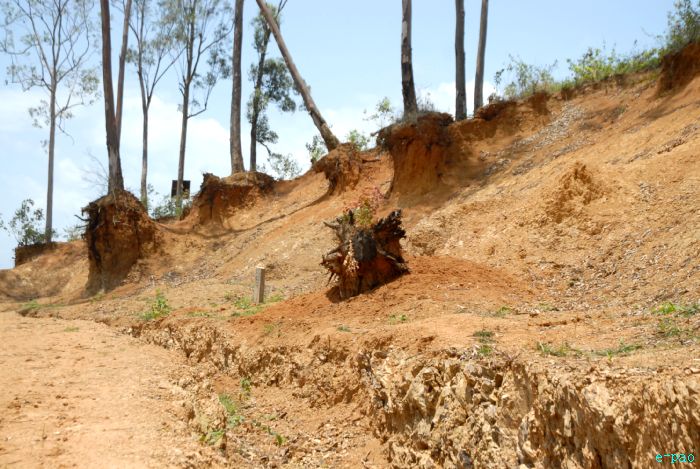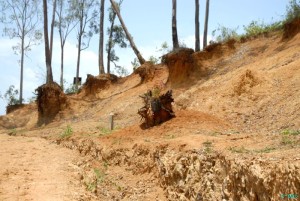Every month, we celebrate festivals of various themes incessantly, and sing to our favourite tunes with dance, good looking youth walks on the ramp, however, not so blessed people beg for foods to survive at commercial stations. People throng to multiplexes to see the first experience of a Box-buster film. Sudden burst of rains creates havoc throughout the city, blocking roads and gives birth to ugly epidemics. We lament on the sudden three days outpouring of rain, but not bother to decipher the reasons of it. An incomplete project on “Ecology system” of our little ones lying on the tables silently shouts the reason of this natural phenomenon.
The situation now has become quite critical. The forest cover of the state is depleting day by day due to indiscriminate felling and burning of trees to meet the demands of the fast growing population. Today, one can witness the level of destruction if one reaches a nearby hill within half an hour ride from the capital Imphal in any direction of the State.
Although the hills of Manipur look beautiful when viewed from a distance, the reality is quite a bummer. The ground reality is that there is hardly any big and mature tree grown in the site, and whatever trees grown are also in the process of cutting down either for charcoal or firewood or timber. This insane act of human has destroyed most of the natural habitats of wild life over the last few decades. If the devastation of forest and wild life continues at the present level, then the time is not far for us to witness the looming Environment Catastrophe.
It is evident from the fact that deforestation and environment degradation in Manipur have inflicted so much to the ecosystem of the state. Illegal hunting and poaching by villagers using fire arms and traps are increasing tremendously. Mass destruction of forests by way of felling, burning and logging trees compelled the wild animals and birds to displace themselves and seek for new habitats which are limited. Almost all the species of wild animals and birds which were abundant at one time in the state are now at the verge to extinction. Many endemic species of wild animals and birds that are rare in the world are regarded extinct today.
The State Bird Nong-in (Mrs. Hume’s Pheasant Bird), the Green Peafowl, the Hooded Crane, Hoolock Gibbon, Manipur Bush Quail, Golden Cat etc. are some of such extinct or near to extinct species. In fact, today, we have not heard the wake-up call of many birds at dawn, we have missed the charming sight of acrobatic kites & hovering hawks, the ever melodious Cuckoo, the sound of barking deer, the roar of the tiger, the movement of the magnificent Tuskers, the chattering of the monkeys and so on. The list goes on.
Fortunately, the State animal of Manipur called Sangai (Brow Antlered Deer), once faced extinct some 60 years ago, is now somehow safe. Thanks to the Government of Manipur and the Department of Forest & Wild Life for their conservation initiative by declaring Keibul Lamjao, the natural habitat of Sangai as a National Park in the year 1977. It is due to the conservation initiative of the Government of Manipur that the number of Sangai which was a mere 6 in the year 1953 has now risen to almost 200.
However, many rare species such as Mrs. Hume’s Pheasant (Nongin), Green Peafowl, Slow Loris, Hornbill, Manipur Bush Quail, Fish Eagle, Hooded Crane, Golden Cat, Assamese Macaque, etc. which are listed in the IUCN Red List of endangered species are not so lucky. Perhaps the last few of these species are now facing the onslaught of man in the remote forests of the state today.
While discussing about these vanishing birds and animals, one might think and ask that why we give so much of importance and focus on the wild animals and birds? Why so much hue and cry for these bloody creatures? Don’t we have other human related problems to deal with? The straight answer is “No” because it is the only option we have as far as environmental issues are concerned. As we all are aware of the fact that the Ecosystem of the planet involves all the living organisms.
Every living organism, big or small contributes to the process of the ecosystem in one way or the other. Plants use energy released from the sun and in turn they are used by other living creatures as food, and the cycle continues as plant & animal life forms, die and are consumed by micro organisms. Birds and animals also play a great role in maintaining the ecosystem of the earth. Birds, help human beings in controlling insects, pest and rodents as many predatory birds such as Hawks, Kites, Eagle, Owl prey on mice, rats, insects etc. which otherwise are great danger to human.
Birds also help human being by way of pollination from one plant to another. Likewise, the presence of tiger and lion in the forests help to control the population of deer and other small animals. They also help preserve the forests by scaring away humans from their habitats. Forests in turn monitor and regulate the flow of water, check flood and draught, stop soil erosion, absorb carbon dioxide from the atmosphere and store it under their covers and release oxygen and thus regulate the climate of the earth as whole.
However, today, this delicate balanced cycle of life and ecosystem on this planet is in great danger as a result of over exploitation of forests natural resources all over the world. Man, in the name of civilisation has inflicted on the ecosystem of the earth so much that the very act of man has now become a direct threat not only to the survival of the wild life and other living organisms but also to the very life of humankind.
Having Sounded of severe adverse impact from the present phenomenon of mass deforestation and killing of wild life in the state, the Resource Mobilisation Centre (an NGO) based out at Heingang, Imphal East District decided to launch a Campaign called “Safe Environment Campaign” on 1st June 2012 with the sole objective of taking up environment related programme towards a safe and green environment of the State in particular and North East Region in general.
As a part of the Campaign, firstly, the organisation conducted a survey on the impact of mass deforestation and killing of wild animals & birds in the hills of Imphal East and a part of Senapati District, from 10th, January, 2013 to 26th March, 2013. The Survey was conducted by a committee headed by Mr. Mutum Inaobi Singh (Chairman of the Campaign Committee). Surprisingly, during the Survey, it was found that a large number of armed villagers from the nearby areas were freely moving around killing wild animals and birds unabated.
The number of poachers with firearms spotted during the survey period, were 45 and with traps and other weapons were 15 and it was estimated that about 50 wild animals and birds ranging from deer, wild pig, jungle fowl, wild cats, hawks, owl, porcupine etc. were killed during the survey period. Ironically, the firearms used by the poachers are single bore barrel guns licensed by the State Government for their own protection.
Interestingly, the farmers living in the surveyed area have already started facing rodent problems as a result of over hunting and killing of predatory wild animals & birds. The population of rodents especially rats are seen multiplying due to the absence of predatory birds and animals. As we surveyed, we came across a case of rodent attack at a farm located at Utonglok, near Taorem Village in which 80% of one acre of tapioca crop was damaged by rats.
Later, the rats also attacked the farm poultry ripping off the flesh of 45 young ducks and imputing another 23 in a single night. Surprisingly, we also came across a case of rats eating the flesh of their trapped colleagues during night time at the same farm. This perhaps may be due to non-availability of enough food to eat for the rapidly increased rodent population in the area. This has shown the degree of rodent menace in the area where this sort of incident had never happened before.
The team also rescued two baby owls along with their mother alive from a felled tree hole nest from Mapao hills which otherwise would have been killed by poachers or other predatory animals.
After having a good and shocking as well experience in the field, the team for “Safe Environment Campaign” 2012-2017 sponsored by Resource Mobilisation Centre, Heingang concluded its 75 days survey on the impact of deforestation and illegal hunting and killing of wild animals and birds at Imphal East and part of Senapati District, Manipur and the following questions came up for discussion in the Campaign Committee Meeting held on the 30th March, 2013 at the office chamber of the Campaign Committee at Heingang.
1) What prompted people to indulge in indiscriminate felling & burning of trees in the hills?
3) Why the Law-enforcing Agencies of Manipur fail to enforce Manipur Forest Rules of 1971 and Wild Life Protection Act 1972 in the state?
5) Is there a weakness in the Manipur Forest Rules of 1971 and the Indian Wild Life Act of 1972?
6) If so, then should we remain as silent spectators even when the situation has become out of control?
After a thorough discussion on the above cited matters, the Campaign Committee unanimously resolved that whatever the reasons and difficulties may be, there is nothing more important than protecting & saving forest and environment of our Mother Earth because sustainability of life of all living organisms (including human beings) on the earth depend on the existence of a sound and balanced ecosystem of forests and environment.
Hence, the Campaign Committee members present resolution to intensify the “Safe Environment Campaign” by involving more people, more students, more stake holders & governments and most importantly the forests dwellers. We therefore appeal to all the people of Manipur specially the villagers who live in and around the forests not to indulge in unscientific and unsustainable destructive activities of forests & wild life any longer as the well-being of our own children future simply lies on the existence of a sound and balanced ecosystem of which forests, wild animals and birds are the main players. So, let us join hands together for a healthy and safe environment tomorrow for the sake of our children before it is too late.
Article Source – E-Pao

